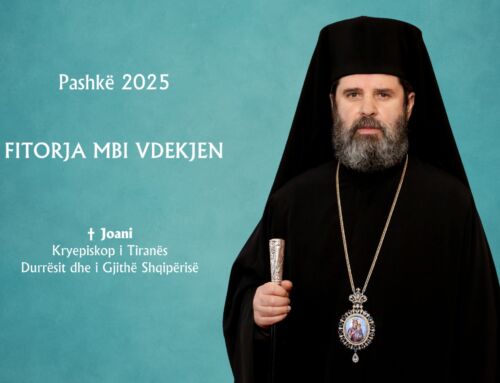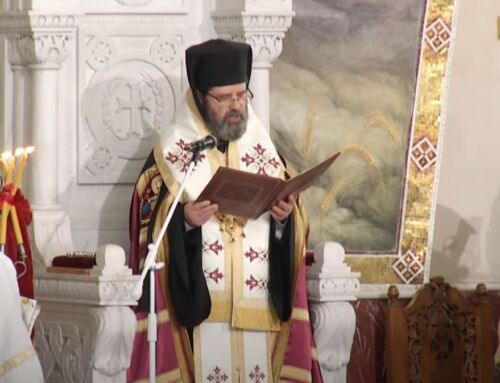The Papacy
The West in the fifteenth century was in turmoil over, the relationship between the papacy and church councils. Some held that the papacy was supreme. Others held that the authority of the church councils supercedes that of the pope. A council was called in Ferrara-Florence (1438-1439) to consider that question. Representatives of the Eastern Church arrived at this council once again looking for help in the struggle against the Turks. Among the Eastern Churchmen who were accepted at the council on “equal terms” with the Latins, were the emperor of Constantinople, John VIII; the patriarch of Constantinople, Joseph; and, the Metropolitan of Kiev, a Greek named Isidore.
The Council of Florence
At the council of Florence the Eastern representatives accepted a strong doctrine of papal power – although the issue was not deeply discussed – and the doctrines of filioque and purgatory. The Byzantine emperor pressed to stop theological discussions in the hopes of completing the union. All the Orthodox bishops signed the union statement except Mark Eugenikos, the bishop of Ephesus.
The union of Florence was not publicly proclaimed until 1452 in Hagia Sophia in Constantinople. On May 29, 1453, the Turks under Mohammed II took the city which was renamed Istanbul, marking the end of the Byzantine Empire. The first act of the patriarch Gennadios Scholarios after the fall of Constantinople was to repudiate the union of Florence. The patriarch was under strong pressure of St. Mark of Ephesus in this action. Saint Mark, the firm defender of Orthodoxy against what has come to be called through him the “unrighteous union,” was canonized a saint for his actions.
Russia
Just as the Byzantine empire was falling to the Moslems, the seeds of the coming Russian empire were beginning to take root in Moscow. Ivan III the Great (1462-1505), the Muscovite prince, succeeded in extending his role in the Russian north by defeating and annexing Novgorod. He married the Byzantine princess Sophia Paleologos in 1472, and accepted the title of Tsar (the Slav form of the old Russian imperial title of Caesar) and the symbol of the double-headed eagle. The ideology of Moscow as the “third Rome” after Constantinople was being born.
In fifteenth-century Russia a great controversy was waged over the role which the Church should play relative to the political and social life of the nation. The two leaders of the controversy – both of whom shared the legacy of Saint Sergius, and both of whom are canonized saints of the Church – were Nilus of the Sora (Nil Sorsky, 1433-1508) and Joseph of Volotsk (1439-1515).
Saint Nilus led the party of the “non-possessors” who lived beyond the Volga River. They are sometimes called the “transvolgans.” The “non-possessors” held that the Church, particularly the monasteries, should be free from owning and ruling over large properties. They held that the Church should be free from the direct influence and control of the state. They defended poverty as the chief virtue, with humility and spiritual freedom dominating the contemplative, silent life for monks. They were the inheritors of the mystical, hesychastic, and kenotic tradition of Saint Sergius and early Kievan spirituality.
The “possessors” were led by Saint Joseph. Hence, they are sometimes called the “Josephites.” They held that the Church and state should be in the closest possible relationship, and that the Church should serve the social and political needs of the emerging Russian nation. The ideal of the “possessors” was that the Church, particularly the monasteries, should control vast properties. The Church should foster a life of ascetic discipline and social service among the people which would be rooted in the strict observance of liturgical and cultic rituals. In this tendency the “possessors” also followed the tradition of Saint Sergius. Both Saint Sergius and Metropolitan Alexius played a very prominent role in Russian social and political life of the fourteenth century, as well as continuing the original Byzantine legacy of the Russian Church and nation which was present in the land from its earliest Kievan beginnings.
Although the spirit of the “non-possessors” always remained in Russian Orthodoxy, it was the way of the “possessors” which dominated Russian ecclesiastical and national development in subsequent centuries.
The Fall of Byzantium
Serbia fell to the Turks in 1459, Greece in 1459-60, Bosnia in 1463, and Egypt finally in 1517. For the next four hundred years the Moslem Turks held sway over the Orthodox Christians in the former Byzantine empire in the East.
The West
In the West, the fifteenth century saw the continual resistance to the power of the papacy by the conciliar movement mentioned already; by the rise of national consciousness among the various Western European peoples; by the religious movements forerunning the reformation era; and by the humanist movements of the renaissance now becoming most powerful in their stress on the natural man through the rebirth of interest in ancient Roman and Hellenistic culture. The name of Erasmus (d.1536) must be mentioned in this regard, as well as the artists and scientists such as Leonardo di Vinci (d.1519) and Raphael (d.1520).
Further mention must be made of the Czech leader Jan Hus who was condemned and burned at the stake in 1415 at the Council of Constance for his opposition to the pope and the practices of the Roman Church; of Savonarola, the fiery Dominican friar of Florence, who was burned to death by papal instigation in 1498 for his denunciation and condemnation of churchly wickedness and sin; of Fra Angelico (d.1455), the Florentine painter, many of whose masterpieces hang in Savonarola’s monastery of San Marco in Florence; and of Donatello (d.1466), Fra Filippo Lippi (d.1469), and Botticelli (d.1510).


